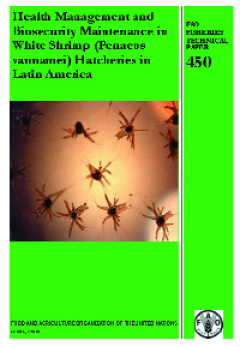Focus on pre-spawning and post-spawning processes

The Food and Agriculture Organization (FAO) of the United Nations recently published a technical paper with the aim of helping Latin American hatchery operators produce quality, disease-free (Penaeus vannamei) postlarvae, thus improving production and the sustainability of white shrimp aquaculture in the area.
FAO paper 450, titled “Health Management and Biosecurity Maintenance in White Shrimp Penaeus vannamei Hatcheries in Latin America,” is currently available only in English. A Spanish version will be available soon.
The document was compiled through an extensive consultative process undertaken 2001-2003 that involved input from government-designated national coordinators, regional and international experts, representatives from intergovernmental organizations and the private-sector, and FAO. The process was made possible through the FAO Regional Technical Cooperation Program project Assistance to Health Management of Shrimp Culture in Latin America, which involved the participation of 14 countries in the region.
Healthy postlarvae key
During efforts to find lasting solutions to the disease problems affecting P. vannamei culture in Latin America, it was perceived that stocking with healthy postlarvae was a key factor for achieving better survival during production. However, the successful production of healthy post-larvae requires a clear understanding of the principles of sound health management and hatchery biosecurity.
Production and spawning
The paper has three main sections that focus on reffective hatchery production, the pre-spawning process, and the post-spawning process. It provides technical guidance on how to improve the health and quality of postlarvae produced in hatcheries through proper facility maintenance, husbandry and broodstock quarantine. It addresses spawning and maturation, larval rearing, feeding, water quality, biosecurity and health management, using interventions at different points of the hatchery production process.
SOPs, health and quality assessments
“Health Management and Biosecurity Maintenance in White Shrimp Penaeus vannamei Hatcheries in Latin America” also provides valuable information on how standardized operating procedures and hazard analysis critical control point (HACCP) interventions can be applied during the hatchery production of P. vannamei postlarvae.
There are clear instructions on the potential uses and dosages of chemicals recommended by the Office International des Epizooties. The paper describes methods for the health assessment of larvae and postlarvae based on gross observation, light microscopy and basic bacteriology, and laboratory methods such as polymerase chain reaction or immunodiagnostics. A description of quality assessment that applies a scoring procedure for selecting postlarvae for stocking is also provided.
Copies of the publication can be requested by e-mailing Dr. Rohana Subasinghe at FAO, rohana.subasinghe@fao.org.
(Editor’s Note: This article was originally published in the August 2004 print edition of the Global Aquaculture Advocate.)
Now that you've finished reading the article ...
… we hope you’ll consider supporting our mission to document the evolution of the global aquaculture industry and share our vast network of contributors’ expansive knowledge every week.
By becoming a Global Seafood Alliance member, you’re ensuring that all of the pre-competitive work we do through member benefits, resources and events can continue. Individual membership costs just $50 a year. GSA individual and corporate members receive complimentary access to a series of GOAL virtual events beginning in April. Join now.
Not a GSA member? Join us.
Authors
-
Victoria Alday-Sanz, Ph.D.
INVE Technology NV
Oeverstraat 7
B-9200 Baasrode, Belgium -
Rohana P. Subasinghe, Ph.D.
Senior Fishery Resources Officer (Aquaculture)
Fisheries Department
U.N. Food and Agriculture Organization
Rome, Italy
Related Posts

Health & Welfare
Alphavirus replicon particles potential method for WSSV vaccination of white shrimp
A study demonstrated that VP19 and VP28 white spot syndrome virus envelope proteins expressed by replicon particles provided protection against mortality due to WSSV in shrimp.

Health & Welfare
Ammonia addition enhances microbial flocs in nursery phase for Pacific white shrimp
In a study, “pre-fertilization” in the nursery phase of a biofloc system for shrimp was tested. The objective was to accelerate the biofloc formation to minimize ammonia concentrations, avoiding high peaks during culture.

Aquafeeds
A look at protease enzymes in crustacean nutrition
Food digestion involves digestive enzymes to break down polymeric macromolecules and facilitate nutrient absorption. Enzyme supplementation in aquafeeds is a major alternative to improve feed quality and nutrient digestibility, gut health, compensate digestive enzymes when needed, and may also improve immune responses.

Responsibility
A look at various intensive shrimp farming systems in Asia
The impact of diseases led some Asian shrimp farming countries to develop biofloc and recirculation aquaculture system (RAS) production technologies. Treating incoming water for culture operations and wastewater treatment are biosecurity measures for disease prevention and control.


